Australia national rugby union team
The Australia national rugby union team is the national team of Australia in the sport of rugby union and represents the country in all men's international matches (test matches). It is usually referred to as the Wallabies. This term refers to several species in the kangaroo family, which in turn are the country's national animals. For marketing reasons, the national team is referred to at official level as the Qantas Wallabies.
The team's most important international appearances come at the quadrennial World Cup. The Wallabies have competed every time since their inception in 1987 and are the third most successful team in the tournament with two titles, behind New Zealand and South Africa, who have won three titles each. The Wallabies won the 1991 World Cup final against England and the 1999 World Cup final against France. Australia also reached the finals of the 2003 World Cup and the 2015 World Cup, losing to England and New Zealand respectively.
Since 1996, the Wallabies have participated in the annual Rugby Championship tournament (known as the Tri Nations until 2011). Participants are the four best national teams in the southern hemisphere: the Pumas from Argentina, the All Blacks from New Zealand, the Springboks from South Africa and the Wallabies. The Rugby Championship will see the Wallabies play Argentina for the Puma Trophy, New Zealand for the Bledisloe Cup and South Africa for the Mandela Challenge Plate. The Wallabies have won the Tri Nations three times (2000, 2001 and 2011), and the Rugby Championship for the first time in 2015.
The Wallabies played their first international match in 1899, when Australia took on the British Lions. The central governing body for the Wallabies is Rugby Australia, which is part of the first tier of World Rugby, along with ten others. The national team wears the country's traditional sporting colours of green and gold at both their home and away matches. In 2001, World Rugby awarded them "Team of the Year". 14 former players have been inducted into the World Rugby Hall of Fame.
Organization
→ Main article: Rugby union in Australia
The body responsible for organising rugby union in Australia is Rugby Australia, until 2017 called the Australian Rugby Union (ARU). The ARU was founded in 1949 and joined the International Rugby Board (IRB, now World Rugby) in the same year. Rugby Australia comprises eight regional unions, each representing a state or territory. The highest rugby union league in Australia is the National Rugby Championship, in which seven Australian teams and one from Fiji participate.
In addition to the national team itself, Rugby Australia calls up other selection teams. The Junior Wallabies form the U-20 national team and take part in the corresponding world championships. Children and young people are already introduced to the sport of rugby at school and depending on their interest and talent, training then begins. For school children, there is the Australian Schoolboys national team, which has developed as a precursor to the Wallabies.
Superimposed on the national championship is Super Rugby, an international championship shared with teams from Argentina, New Zealand and South Africa, in which a Japanese team also took part until 2020. With little overlap between the seasons, many players play in both the domestic and international leagues.
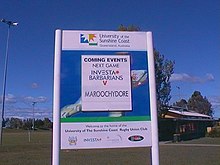
Rugby pitch at the University of the Sunshine Coast, Australia
History
The beginnings
European immigrants played football-like games from very early on, the first newspaper report of which appeared in Sydney in 1829. Most of these early games were played as part of local festivals, with no clear rules and no codified version. The variants played at the time contained elements of several sets of rules that exist today, including Australian football, soccer and rugby. When two teams met, they each had to determine the rules to be applied before the game began. It is no longer possible to determine which variants prevailed in which regions, especially as they were all referred to as football. The first club outside the mother country of Great Britain to follow codified rugby rules (the eighth oldest in the world) was the Sydney University Football Club, founded in 1863, which organised the first official match on 19 August 1865.
In 1874 the Southern Rugby Union (today New South Wales Rugby Union) was founded as the first association, which held the first championship in the same year in the region around Sydney. Two years later the first championship around Brisbane followed, organised from 1883 by the Northern Rugby Union (today Queensland Rugby Union). Rugby soon proved to be the leading ball sport in New South Wales and Queensland, not least because of the regular matches between the select teams of the two colonies from 1882 onwards. In the other colonies (Victoria, South Australia, Western Australia and Tasmania), on the other hand, rugby always had a hard time and quickly fell behind Australian football. The supporters of Australian football, in turn, tried to establish their sport in New South Wales as well. A regional association founded in 1880 initially enjoyed some success, but various social and economic factors led to its dissolution as early as 1893, leaving the two eastern colonies and later states firmly in the hands of rugby.
In 1882, the Southern Rugby Union became the world's first federation to tour another country when its selection, the Waratahs, played five matches in New Zealand. In 1896 the Queensland side, called the Queensland Reds, followed suit. The first Test match for an all-Australian selection took place at the Sydney Cricket Ground on 24 June 1899 when they hosted the touring British Lions from the British Isles. While they won the first match 13-3, they lost the remaining three. The team consisted of six players from Queensland and nine from New South Wales. It played in Sydney in the blue jersey of New South Wales and in Brisbane in the maroon Queensland jersey, but in each case with the Australian coat of arms instead of the logos of the two associations.
Early 20th century
The first match between Australia and the All Blacks of New Zealand took place in Sydney on 15 August 1903 and was lost 3-22. The tour of the All Blacks temporarily led to a surge in popularity for rugby as significantly more spectators attended matches in Sydney and Brisbane. A year later, the British Lions visited again and the Australians lost all three Test matches. The formation of the New South Wales Football League (NSWFL) in 1903 led to a weakening of rugby in New South Wales, with several leading private schools only hosting Australian Football matches instead of rugby matches for a number of years. For a short time it even seemed as if Australian Football was gaining favour with the public as well. The purely amateur sport of rugby union was hit hard in its stronghold by the introduction of rugby league in 1905. Numerous clubs in the Sydney area switched to the professionally run version and founded their own association, which was able to convince Catholic schools in particular to switch to the league code. These schools are still regarded as pillars of League dominance in the Sydney area today. Prominent national players such as Dally Messenger also switched and helped the competition break through.
In 1908/09 the national team undertook their first tour of several months to the British Isles and North America. At the 1908 London Olympics, held during the tour, the Wallabies won the gold medal with a 32-3 victory over Cornwall County in the only match of the tournament. The first Test match against Wales was lost 6-9, however the Wallabies defeated England 9-3 to record their first away win. When the team returned home, eleven players who had travelled with them moved to League clubs.
In addition to the contrast between amateur and professional sport, a cultural contrast also developed: Rugby Union was increasingly seen as a sport for the educated, British upper and middle classes. Rugby League, on the other hand, found its supporters mainly among the working class, which consisted mainly of Catholic Irish and was sceptical or even hostile towards the British Empire. For them, the time-honoured rugby union was an epitome of imperialism. Often the personnel of League clubs were identical with those of branches of the Australian Labor Party. Within a few years League rose to dominate, while Union's star began to fall.
Effects of the World Wars
Rugby Union was hit even harder by the First World War. All sporting associations were faced with the question of whether it was still appropriate to maintain a playing operation when thousands of young Australians were losing their lives on the battlefields of Europe. The Australian Football and Rugby League associations decided to continue to run championships, while the Rugby Union associations suspended their activities completely for the duration of the war, continually accusing their competitors of acting unpatriotically. The social rift that developed at that time shaped relations between the sports and their supporters for decades. During the course of the war, more than 35 national players were on active wartime duty, with ten of them dying. After the end of the war, again many Union players moved to League clubs. In 1920 the Queensland Union even disbanded for lack of players.
In the 1920s, the Wallabies were effectively identical to the Waratahs, the New South Wales side, as they were the only side with a regular playing system. The Waratahs regularly played the Springboks of South Africa and the All Blacks of New Zealand, losing the majority of their matches. These matches were subsequently granted Test match status by the Australian FA, but not by the South African and New Zealand FAs. In 1927/28 the Waratahs toured Europe and Canada with great success for six months, winning 31 of 37 matches. Among others, they defeated the national teams of Ireland, Wales and France, but lost to Scotland and England; all of these encounters are retrospectively considered Test matches. In 1928, the re-establishment of the Queensland Rugby Union sparked a spirit of optimism that led to the reintroduction of an official national team, culminating in three consecutive victories over the All Blacks a year later.
In 1931, Lord Bledisloe, the Governor-General of New Zealand, donated a cup for which the teams of New Zealand and Australia were to play regularly. In 1934 the Wallabies managed to capture the Bledisloe Cup for the first time. A year earlier they had made their first visit to South Africa, losing three Test matches to the Springboks and winning one. After their successful tour of New Zealand, the Springboks visited Australia in 1937 and won two Test matches there. The Wallabies' tour to Europe, scheduled for 1939, did not go ahead as planned. Just one day after arriving in England, World War II broke out and all matches were cancelled. After a two-week stay, the Wallabies returned home. They played their only match during a stopover in Mumbai. Meanwhile, the leading associations decided to maintain at least limited fixtures to avoid the mistakes made during the First World War.
Postwar years
The first Test match after the end of the war was played in Dunedin in 1946 between Australia and New Zealand, with the All Blacks winning 31-8. The four other Test matches on this tour (including one against the Māori) were also lost. In 1947/48 the Wallabies undertook a successful tour of Europe and North America, winning 32 of 39 matches. They won three of the five Test matches, losing to the Welsh and French. In 1949 the Wallabies hosted the Māori for three Test matches; both teams won one game each and played to a draw once. In the same year, the Wallabies played the All Blacks twice away from home and lifted the Bledisloe Cup on New Zealand soil for the first time. The New Zealanders always pointed out afterwards that they had only fielded a B team, as the actual national team was away in South Africa at the time. From New Zealand's point of view, only the All Blacks' three Test matches in Australia two years later could be considered equal (they ended in three Australian defeats).
Also in 1949, the Australian Rugby Football Union (later the Australian Rugby Union, now Rugby Australia) was formed, and the New South Wales and Queensland associations, which had previously been virtually the sole governing bodies, joined it. The main reason for the merger was the International Rugby Board's (IRB, now World Rugby) invitation to Australia, New Zealand and South Africa to join the international body as full members. The IRB had previously only included the associations of the four British Home Nations. Australia had been an associate member since 1926 and was able to voice its concerns through the delegates of the English Rugby Football Union.
The British Lions toured Australia in 1950 and won both Test matches. The following year the All Blacks visited and won all three Test matches against the Wallabies. In July and August 1952, Australia played Fiji for the first time and surprisingly lost by two points in the second Test match. A month later the Wallabies redeemed themselves with an away win against New Zealand. In 1953 they toured South Africa again. In the second Test match they inflicted their first defeat in 15 years on the Springboks. The South Africans were so impressed with the performance that two players carried Australian captain John Solomon off the field on their shoulders. In 1957/58 the Wallabies toured Europe again, but failed to prevail in any of the Test matches against the Five Nations participants. To date (2020), no national team in the southern hemisphere has repeated that negative record.
The 1960s and 1970s were a mixed bag
In 1961 the Wallabies toured South Africa again, losing heavily to the Springboks in both Test matches. On their return, the Wallabies suffered their first home defeat to France. In 1962 Australia played the All Blacks five times; however, apart from one draw, there was no success. After defeating the first touring English in 1963, the Wallabies toured South Africa and won two of the four Test matches. Two years later, the Wallabies managed two home wins against the Springboks. This was the first time the Australians had ever won a match series against South Africa. In June 1966 the British Lions toured Australia and defeated the Wallabies in both Test matches. The tour of Europe in the winter of 1966/67 was not particularly successful, with the Wallabies winning only 19 of the 36 matches played. Of the five Test matches on the schedule, they won those against Wales and England, while suffering defeats to Scotland, Ireland and France. After the tour, Australia hosted Ireland in Sydney and lost again; making Ireland the first of the Home Nations to manage an away win in the southern hemisphere. Until the end of the 1960s, with the exception of a narrow 11-10 home win over France, defeats followed exclusively, including three successive defeats to New Zealand in 1967 and four successive defeats to South Africa in 1969.
The Wallabies' activities in 1971 were to become the most controversial in the history of Australian rugby. The Springboks were due to pay a six-week visit to Australia in July and August, following the Wallabies' visit two years earlier. While the Australian government supported the visit, there were protests in Adelaide, Brisbane, Melbourne, Perth and Sydney against South African apartheid. During these demonstrations there were clashes between participants and police forces. It is estimated that between 500 and 700 protesters were arrested. Although the tour was not stopped, the sports venues resembled fortresses with barbed wire barriers and had to be guarded by a large police contingent. Johannes Bjelke-Petersen, the Premier of Queensland, declared a month-long state of emergency on July 14, which developed into a 24-hour strike by 125,000 workers. There were no more matches against the Springboks until the end of apartheid.
In November 1971 the Wallabies left for a tour of France (one win and one loss). France in turn visited Australia in June 1972 for two Test matches, winning one and drawing the second. Australia then played three Test matches against the All Blacks in New Zealand, losing all of them. In June 1973, Tonga visited for the first time; the Australians still managed to win the first Test match, but lost the second. In November 1973 Australia undertook a short tour to Great Britain, with two emphatic defeats to Wales and England. The All Blacks' 1974 tour to Australia ended in two defeats and a draw for the Wallabies. In 1975, Australia gained revenge twice at home against England. This was followed by their first two encounters with Japan, both of which ended in emphatic Australian victories. During their 1975/76 European tour, the Wallabies lost to Scotland, Wales and England, while edging Ireland. On the way home, the Wallabies stopped off in Los Angeles and defeated the USA in their first meeting.
Australia ended 1976 with a short tour to Europe, which brought two defeats to France. After failing to play a single Test match in 1977, two home wins over Wales and two away defeats to New Zealand followed in 1978. The Wallabies won the third match against the All Blacks 30-16, thanks in no small part to four tries by the outstanding Greg Cornelsen. In June 1979 Ireland visited Australia and defeated the Wallabies in both Test matches. In October 1979 the Wallabies set off on their first tour to Argentina. They lost their first Test match against the Pumas and then evened the series with a win.
Growing strength in the 1980s
In 1980 the Wallabies took the Bledisloe Cup for only the fourth time, having defeated the All Blacks at home in two of three Test matches. The 1981/82 tour to the British Isles ended in disappointment, with only one win in the four Test matches coming against the Irish and three defeats to provincial and regional sides. However, the team was largely made up of young, inexperienced players whose best days were yet to come. In the autumn of 1984 the Wallabies travelled to Great Britain again and achieved a historic feat: they became the first Australian team to achieve a Grand Slam, i.e. victories against all four Home Nations during the same tour. They also overcame a strong Barbarian FC side. The standout player was Mark Ella, who scored a try in each of the four Test matches, something no one before him had achieved. The tour heralded Australia's rise as a force to be reckoned with in international rugby.
In 1986 the Wallabies travelled to New Zealand for three Test matches in the Bledisloe Cup. New Zealand rugby was in turmoil at the time because an unofficial team - the New Zealand Cavaliers - had flouted the apartheid boycott and toured South Africa with most of the All Blacks players. On their return, the federation did not nominate the Cavaliers for the All Blacks' first Test match, which Australia won by one point. The Cavaliers were eligible again for the two other matches. Australia clinched the series with 2-1 victories and regained the trophy. Thus, for the first time ever, the Wallabies decided a Test match series in New Zealand in their favour. The Australian Rugby Union had been at the forefront of the Rugby Union World Cup's inception, co-organising the inaugural edition with New Zealand in 1987. The confident Wallabies beat England, the USA and Japan in the preliminary round and Ireland in the quarter-finals. Then, however, they failed in the semi-finals with 26:30 to France, also the game for third place against Wales was lost.
The Wallabies' performances had steadily improved under coach Alan Jones, who had been in charge since 1984, but he had a polarising effect as he was also a broadcaster on the side and many players were unhappy with his management style. In particular, there were serious discrepancies with the influential scrum-half Nick Farr-Jones. After the 1987 World Cup, Jones was sacked as coach and replaced by Bob Dwyer, who had previously coached the Wallabies in 1982 and 1983. The home series against the All Blacks that year was disappointing as the Wallabies managed only one draw in three Test matches. In 1989, the British Lions visited Australia for the first time since 1966. After the opening win, the Wallabies lost the remaining two Test matches, dropping the series 2-1. Dwyer identified the lack of forward dominance as a major factor in the losing series and declared a goal for the 1990s to improve this facet of the Wallabies game.
World championship titles 1991 and 1999
In August 1990, Australia won a match in New Zealand for the first time in four years. The All Blacks were also beaten in preparation for the 1991 World Cup, as were Wales and England. The Wallabies therefore approached the World Cup with renewed confidence, beating Argentina, Wales and Samoa in the preliminary round, some of them emphatically. They were on the brink of elimination in the quarter-finals against Ireland in Dublin when Michael Lynagh scored a try on the edge of the box with just seconds remaining to send the Irish out of the tournament and put Australia into the semi-finals against New Zealand. In this the Wallabies prevailed in commanding fashion, after which they met England in the final. The English changed their dominant play to a more fluid game. However, this proved unsuccessful and the Wallabies won 12-6, with David Campese named player of the tournament after contributing six tries to Australia's world title.
When the Springboks were allowed back into international rugby in 1992 after the end of apartheid, the Wallabies paid them a visit and won the first Test match between the two teams in more than two decades. In 1993 the Springboks made a return visit to Australia for three Test matches, of which the Wallabies won two. In 1994, the Wallabies won twice each against Ireland, Italy and Argentina, among others. Their title defence during the 1995 World Cup in South Africa began with a loss to the hosts, followed by victories over Canada and Romania. The Wallabies were eliminated by England in the quarter-finals after Rob Andrew scored a drop-goal in extra-time to make the final score 22-25.
In August 1995, the IRB decided to open the game to professional players in order to counter the increasing poaching of good players by financially strong rugby league clubs. That same year, the South African, New Zealand and Australian federations formed the SANZAR consortium to market television broadcast rights for two new competitions, the Super 12 international league (now Super Rugby) and the Tri-Nations national team tournament (now The Rugby Championship). With the new competitions leaving little time for month-long overseas tours, this tradition of the amateur era came to a swift end (with the exception of the Lions' tours every four years). In response to the professionalisation of rugby, the Rugby Union Players' Association (RUPA) was formed in October 1995 to represent the concerns of Australia's professional players.
In 1996 and 1997, the first two editions of the Tri Nations, the Wallabies won just two of their eight Test matches, both at home to South Africa, and suffered record away defeats to both the Springboks and the All Blacks. After Rod Macqueen took over as national coach in 1998, the Wallabies won both Test matches against New Zealand and regained the Bledisloe Cup. That same year, during an inexperienced England team's tour to the southern hemisphere, the Wallabies managed a record 76-0 victory, still the highest defeat for England. The defence of the Bledisloe Cup followed in 1999 after the Wallabies defeated the All Blacks 28-7 in Sydney, equalling New Zealand's highest defeat to date.
During the 1999 World Cup, the Wallabies finished first in the group stage after allowing just 31 points in their three games against Romania, Ireland and the USA combined. The Wallabies met Wales in the quarter-finals, winning 24-9 to progress to the semi-finals. They beat defending champions South Africa 27-21 in the semi-finals, which was decided in extra-time by a drop-goal from link half Stephen Larkham and a penalty from fly-half Matt Burke. Australia cruised to an effortless 35-12 victory over a tiring French side, who had previously knocked out favourites New Zealand in the semi-finals, at the Millennium Stadium. Burke contributed most of the points in the win. The Wallabies thus became the first team to lift the Webb Ellis Cup for a second time.
In the new millennium
In 2000 Australia defended the Bledisloe Cup and won the Tri Nations tournament for the first time. At the Tri Nations 2001 the Wallabies defended the title. They also won a series of Test matches against the British and Irish Lions for the first time. National coach MacQueen resigned after this high point and was succeeded by Eddie Jones. Due to the increased popularity, prominent Rugby League players such as Mat Rogers, Wendell Sailor and Lote Tuqiri moved to Rugby Union and played for the Wallabies from then on. This was in contrast to the previous century when Union players moved to professional Rugby League. In 2001 World Rugby named the Wallabies "Team of the Year" and Rod Macqueen "Coach of the Year".
The Wallabies failed to defend their title at the 2002 Tri Nations. This was followed by unexpected away defeats to Ireland and England. In the 2003 Tri Nations, the Wallabies had to concede the Bledisloe Cup to New Zealand. In the same year, the 2003 World Cup began in impressive fashion for the hosts. The group stage saw convincing victories over Argentina, Namibia and Romania. In their final group game, the Wallabies narrowly edged out Ireland 17-16. They then knocked Scotland out of the tournament 33-16 in the quarter-finals. Their strongest performance came in the semi-finals when they defeated New Zealand 22-10. George Gregan then teased the All Blacks by saying "Four more years boys, four more years". In a thrilling final, the Wallabies lost 17-20 to England, with Jonny Wilkinson's drop goal deciding the game just before the end of extra time.
After the end of the 2005 European tour, which concluded a negative record of eight defeats in nine matches, the press pushed for Eddie Jones to be sacked. In December 2005, the Australian Rugby Union caved in to mounting pressure and replaced him with John Connolly a month later. At the 2006 Tri Nations, the Australians managed a remarkable 49-0 win over South Africa, but performed mediocre in the remaining matches. A rare away defeat to Ireland followed in November that year. On 10 May 2007, Australia and Wales agreed to commemorate the 100th anniversary of the first Test match between the two countries with the launch of the James Bevan Trophy. The trophy is named after the Australian-born first team captain of the Welsh. Australia won the first series of Test matches for the new trophy 2-0.
At the 2007 World Cup, the Wallabies finished first in their preliminary group with some very clear victories over Japan, Wales, Fiji and Canada. However, they were defeated 10-12 by England in the quarter-finals and were eliminated. Connolly tendered his resignation as national coach and was replaced by Robbie Deans in early 2008. With key players George Gregan and Stephen Larkham having ended their careers after the disappointing World Cup, he was faced with the task of assembling a new team. The Wallabies left a mixed impression at the 2008 Tri Nations. They defeated the All Blacks once and the Springboks twice. However, they also suffered their biggest defeat to date: 8-53 to South Africa in Johannesburg. In 2009, the Wallabies initially defeated Italy twice and France once, but thereafter their performances declined sharply as they lost three times to New Zealand and twice to South Africa. In the 2009 End-of-year Internationals they lost to Scotland for the first time in 27 years.
Up and down since 2010
The Wallabies scored a victory over South Africa at the 2010 Tri Nations; however, they also suffered their tenth consecutive defeat to New Zealand - a new negative record. However, at the 2010 End-of-Year Internationals, the Wallabies beat the All Blacks in a close match in Hong Kong. This was Australia's first win over New Zealand in three years. For the Wallabies, 2011 began with a surprising home loss to Samoa, but they then went on to win the 2011 Tri Nations, claiming their first title in ten years. The inclusion of Argentina transformed the annual Southern Hemisphere tournament into the Rugby Championship in 2012. In the expanded format, the Australians failed to defend their title, although they did defeat the newcomers twice. The Wallabies won over Italy to open the 2011 World Cup, but lost the following match to Ireland. They still qualified for the quarter-finals with two more wins over the USA and Russia. In the quarter-finals, they faced defending champions South Africa, who were narrowly beaten 11-9 thanks to an almost flawless defensive performance. Finally, the Wallabies failed in the semi-finals with 6:20 against the host and later world champion New Zealand. In the match for third place they won against Wales with 21:18.
In 2012, Australia lost at home to Scotland, their first home defeat to that side since 1982, while in the same year they narrowly beat Italy after Luciano Orquera missed a last-minute penalty that would have given Italy their first draw with the Wallabies. In 2013, the British and Irish Lions visited Australia and won two of the three Test matches. This failure and a meagre winning record contributed to national coach Deans coming under increasing pressure. Indeed, he resigned in July 2013 after six years in charge; he was succeeded by Ewen McKenzie. The 2013 Rugby Championship ended with two defeats each to Argentina and New Zealand, in addition to two wins over the Pumas. The 12-38 home defeat to the Springboks was the highest ever to that point. At the 2013 End-of-year Internationals, McKenzie led the Wallabies to four straight wins over Italy, Ireland, Scotland and Wales. However, having lost the opening game of the series to England, they missed out on the Grand Slam they were aiming for.
In 2014, the Wallabies lifted the Trophée des Bicentenaires for the first time in four years after three straight wins over France. When they followed that up with a draw against New Zealand in the opening game of the 2014 Rugby Championship to remain unbeaten for an eighth successive season, there was the prospect of ending a losing streak for the Bledisloe Cup that had lasted since 2002. But a 20-51 defeat dashed their hopes. Later in the tournament, the Australians suffered their first defeat to Argentina in 17 years; it was also the Pumas' first win since joining the Rugby Championship. McKenzie stepped down as national coach on 18 October 2014, with the ARU introducing Michael Cheika as his successor four days later. In the first Test match under his stewardship, Australia achieved their tenth consecutive victory over Wales in Cardiff. Later in the 2014 End-of-Year Internationals, defeats to France, Ireland and Wales saw the Wallabies slip to sixth in the world rankings.
At the 2015 Rugby Championship, the Wallabies claimed their first tournament win under the new format after defeating South Africa, Argentina and New Zealand once each. For the 2015 World Cup in England, Australia were drawn in a 'group of death' along with Wales, Fiji, the hosts and Uruguay. The Wallabies handled the difficult task with aplomb, defeating all of their group opponents, while England bowed out of the tournament early. In the quarter-finals, the Wallabies faced Scotland, who led until 30 seconds before the final whistle before referee Craig Joubert awarded Australia a controversial penalty kick, which Bernard Foley converted for a narrow 35-34 final score. Australia went on to defeat Argentina 29-15 in the semi-finals, before losing 17-34 to the All Blacks in the final after closing to within 17-21 with a quarter of an hour remaining.
The year 2016 marked the beginning of a serious downward trend. In June, the Wallabies hosted the Eddie Jones-coached English side and lost three Test matches in a row. They also lost to the All Blacks in all three matches. Late in the year they added defeats to Ireland and, for the fourth time, England. The 2017 season started little better as the Wallabies lost to a weakened Scotland side who had provided some players to the British and Irish Lions for their tour to New Zealand. The mediocre performances continued throughout the 2017 Rugby Championship. The end of the season saw a fifth consecutive defeat to England and a record defeat to Scotland. In June 2018, the Wallabies lost two of three games against Ireland, then four of the six games in the 2018 Rugby Championship, and in the autumn they suffered their first defeat to Wales in ten years. Overall, they won just four of 13 Test matches, which is considered their worst calendar year.
In the 2019 Rugby Championship, Australia held off the All Blacks for a 47-26 victory, one of New Zealand's highest defeats in a Test match. In the Bledisloe Cup match that followed, New Zealand returned the favour 36-0. During the 2019 World Cup in Japan, the Wallabies were victorious over Fiji, Uruguay and Georgia in the preliminary round. However, a narrow defeat in their preliminary round match against Wales meant they had to face the heavily rated English in the quarter-finals. After the emphatic 16-40 defeat, the World Cup was over and so was the season for the Wallabies. Michael Cheika announced his resignation as national coach the following day.
.jpg)
Australia v Scotland in Sydney (2017)
.jpg)
Australia vs New Zealand in Sydney (2017)
.jpg)
Australia defeats England during the 2015 World Cup
.jpg)
Australia vs USA during the 2011 World Cup
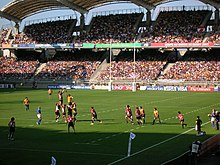
Australia vs Japan during the 2007 World Cup
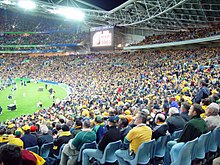
Opening match of the World Cup 2003 between Argentina and Australia in Sydney
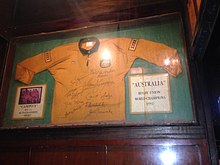
The jersey of David Campese, provided with autographs, in a Hong Kong bar.

Australia v Argentina at Estadio José Amalfitani, 7 November 1987
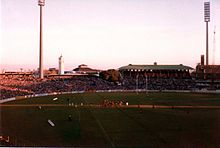
Lane in the second Test match between Ireland and Australia in Sydney in 1979
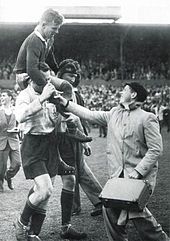
Wallabies captain John Solomon is carried by the Springboks (1953)
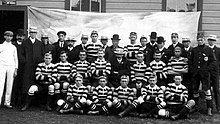
Australian team 1905
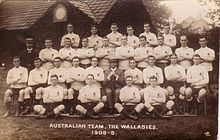
The Australian team of the 1908/09 Tour
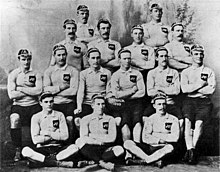
Australian Team 1899
Search within the encyclopedia